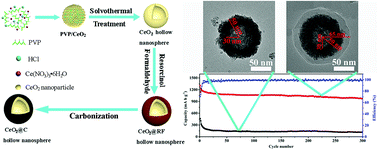Double-shelled CeO2@C hollow nanospheres as enhanced anode materials for lithium-ion batteries†
Abstract
Metal oxide-based nanomaterials are extensively studied as anode materials for lithium-ion batteries (LIBs) because of their high energy densities. However, the practical application of these nanomaterials is hindered by their fast capacity degradation resulting from the large volume expansion upon lithiation. In this work, CeO2@resorcinol and formaldehyde resin (RF) hollow nanospheres were prepared by polymerization of resorcinol and formaldehyde on the CeO2 hollow sphere surface. Mesoporous double-shelled CeO2@C hollow nanospheres were obtained by carbonizing RF in CeO2@RF. The resulting composites display a typical double-shell hollow structure with a cavity diameter of approximately 60 nm. The thickness of the CeO2 layer is approximately 20 nm, and the carbon shell of the outer layer is approximately 15 nm. This double-shelled structure, in which the CeO2 hollow nanospheres are uniformly dispersed inside the carbon nanoshells, can simultaneously act as a conductive framework and a protective buffer layer to restrain volume variations. The fabricated nanospheres exhibit a remarkable electrochemical performance as anodes for LIBs, displaying a high reversible capability (1309.1 mA h g−1 at 100 mA g−1), stable cycling life (903.6 mA h g−1 after 300 cycles at 100 mA g−1), and good rate capacity (761.6 mA h g−1 at 1000 mA g−1). This effective strategy provides new insight into the design and synthesis of other composite electrodes for high-performance lithium-ion batteries.



 Please wait while we load your content...
Please wait while we load your content...